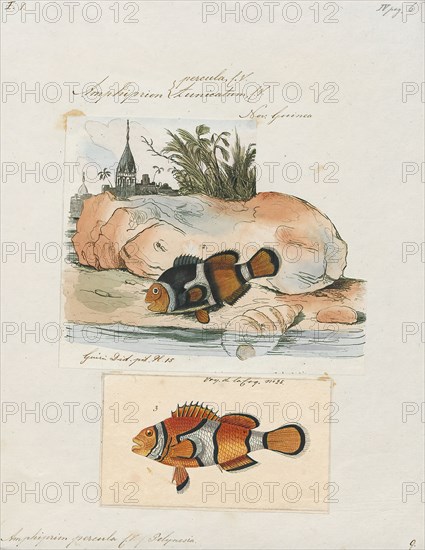
Légende
Amphiprion percula, Print, The orange clownfish (Amphiprion percula) also known as percula clownfish and clown anemonefish, is widely known as a popular aquarium fish. Like other clownfishes (also known as anemonefishes), it often lives in association with sea anemones. A. percula is associated specifically with Heteractis magnifica and Stichodactyla gigantea, and as larvae use chemical cues released from the anemones to identify and locate the appropriate host species to use them for shelter and protection. This causes preferential selection when finding their anemone host species. Although popular, maintaining this species in captivity is rather complex. The Great Barrier Reef Marine Park Authority regulates the number of collection permits issued to aquarium fish dealers who seek this, and other tropical fish within the Great Barrier Reef Marine Park. The symbiosis between anemonefish and anemones depends on the presence of the fish drawing other fish to the anemone, where they are stung by its venomous tentacles. The anemone helps the fish by giving it protection from predators, which include brittle stars, wrasses, and other damselfish, and the fish helps the anemone by feeding it, increasing oxygenation, and removing waste material from the host. Various hypotheses exist about the fish's ability to live within the anemone without being harmed. One study carried out at Marineland of the Pacific by Dr. Demorest Davenport and Dr. Kenneth Noris in 1958 revealed that the mucus secreted by the anemone fish prevented the anemone from discharging its lethal stinging nematocysts. A second hypothesis is that A. percula has acquired immunity towards the sea anemone’s toxins, and a combination of the two has been shown to be the case. The fish feed on algae, zooplankton, worms, and small crustaceans., 1700-1880
University of Amsterdam
Crédit
Photo12/Liszt Collection/Artokoloro
Notre référence
LZT20A45_052
Licence
Droits gérés
Format disponible
50,1Mo (3,3Mo) / 31,2cm x 40,3cm / 3680 x 4754 (300dpi)